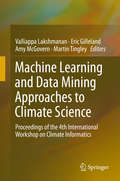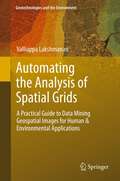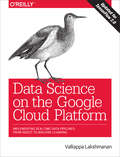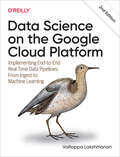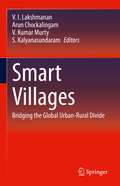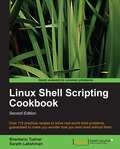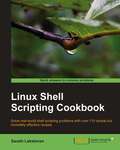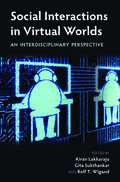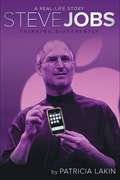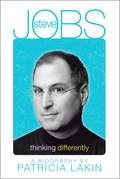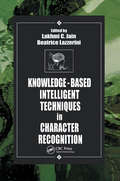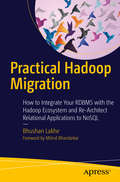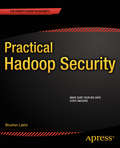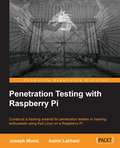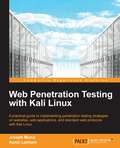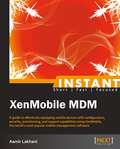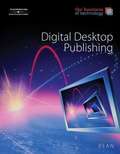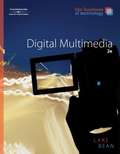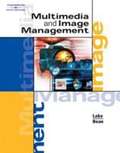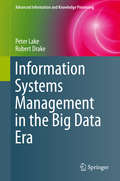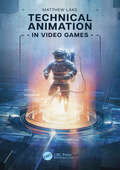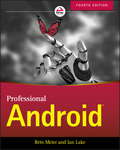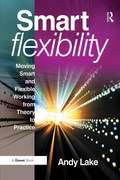- Table View
- List View
Machine Learning and Data Mining Approaches to Climate Science
by Valliappa Lakshmanan Eric Gilleland Amy Mcgovern Martin TingleyThis book presents innovative work in Climate Informatics, a new field that reflects the application of data mining methods to climate science, and shows where this new and fast growing field is headed. Given its interdisciplinary nature, Climate Informatics offers insights, tools and methods that are increasingly needed in order to understand the climate system, an aspect which in turn has become crucial because of the threat of climate change. There has been a veritable explosion in the amount of data produced by satellites, environmental sensors and climate models that monitor, measure and forecast the earth system. In order to meaningfully pursue knowledge discovery on the basis of such voluminous and diverse datasets, it is necessary to apply machine learning methods, and Climate Informatics lies at the intersection of machine learning and climate science. This book grew out of the fourth workshop on Climate Informatics held in Boulder, Colorado in Sep. 2014.
Automating the Analysis of Spatial Grids: A Practical Guide to Data Mining Geospatial Images for Human & Environmental Applications (Geotechnologies and the Environment #6)
by Valliappa LakshmananThe ability to create automated algorithms to process gridded spatial data is increasingly important as remotely sensed datasets increase in volume and frequency. Whether in business, social science, ecology, meteorology or urban planning, the ability to create automated applications to analyze and detect patterns in geospatial data is increasingly important. This book provides students with a foundation in topics of digital image processing and data mining as applied to geospatial datasets. The aim is for readers to be able to devise and implement automated techniques to extract information from spatial grids such as radar, satellite or high-resolution survey imagery.
Data Science on the Google Cloud Platform: Implementing End-to-End Real-Time Data Pipelines: From Ingest to Machine Learning
by Valliappa LakshmananLearn how easy it is to apply sophisticated statistical and machine learning methods to real-world problems when you build on top of the Google Cloud Platform (GCP). This hands-on guide shows developers entering the data science field how to implement an end-to-end data pipeline, using statistical and machine learning methods and tools on GCP. Through the course of the book, you’ll work through a sample business decision by employing a variety of data science approaches.Follow along by implementing these statistical and machine learning solutions in your own project on GCP, and discover how this platform provides a transformative and more collaborative way of doing data science.You’ll learn how to:Automate and schedule data ingest, using an App Engine applicationCreate and populate a dashboard in Google Data StudioBuild a real-time analysis pipeline to carry out streaming analyticsConduct interactive data exploration with Google BigQueryCreate a Bayesian model on a Cloud Dataproc clusterBuild a logistic regression machine-learning model with SparkCompute time-aggregate features with a Cloud Dataflow pipelineCreate a high-performing prediction model with TensorFlowUse your deployed model as a microservice you can access from both batch and real-time pipelines
Data Science on the Google Cloud Platform: Implementing End-to-end Real-time Data Pipelines: From Ingest To Machine Learning
by Valliappa LakshmananLearn how easy it is to apply sophisticated statistical and machine learning methods to real-world problems when you build using Google Cloud Platform (GCP). This hands-on guide shows data engineers and data scientists how to implement an end-to-end data pipeline with cloud native tools on GCP.Throughout this updated second edition, you'll work through a sample business decision by employing a variety of data science approaches. Follow along by building a data pipeline in your own project on GCP, and discover how to solve data science problems in a transformative and more collaborative way.You'll learn how to:Employ best practices in building highly scalable data and ML pipelines on Google CloudAutomate and schedule data ingest using Cloud RunCreate and populate a dashboard in Data StudioBuild a real-time analytics pipeline using Pub/Sub, Dataflow, and BigQueryConduct interactive data exploration with BigQueryCreate a Bayesian model with Spark on Cloud DataprocForecast time series and do anomaly detection with BigQuery MLAggregate within time windows with DataflowTrain explainable machine learning models with Vertex AIOperationalize ML with Vertex AI Pipelines
Smart Villages: Bridging the Global Urban-Rural Divide
by V. I. Lakshmanan Arun Chockalingam V. Kumar Murty S. KalyanasundaramThis book brings together technical expertise, best practices, case studies and ground-level application of the ideas for empowering the rural population of the world to live economically prosperous, environmentally sustainable, and socially progressive lives, on par or comparable with the quality of life enjoyed by the global urban population. The idea of Smart Villages takes on greater urgency in light of the investments made in this millennium on “Smart Cities”, taking advantage of the technological advances, particularly in digital connectivity. These investments have and will continue to expand the urban-rural divide, unless similar investments are made in the villages as well. The book provides a much-needed guide for a holistic development of a Smart Village, by defining the need, developing the framework, and describing the delivery, complete with successful case studies. Contributors to the book, from Canada, USA, Africa and India bring years of academic, industry and governmental experience, including organization of several Smart Village conferences. The knowledge base in the book will be of great value to anyone interested in or active in rural planning, including governmental and non-governmental organizations, industrial solution providers, public healthcare professionals, public policy professionals and students, as well as rural communities around the world. Consolidates all the aspects of creating/developing a Smart Village;Delivers an effective tool-kit for practitioners in the area of Smart Villages;Provides a policy-based framework for the development of an ideal Smart Village;Illustrates, through case studies, the fulfillment of key requirements of a Smart Village;Brings together experts from around the world to share their vision of a Smart Village;Highlights the importance of balancing development with social/gender equity and cultural traditions.
Linux Shell Scripting Cookbook, Second Edition
by Sarath Lakshman Shantanu TusharThis book is written in a Cookbook style and it offers learning through recipes with examples and illustrations. Each recipe contains step-by-step instructions about everything necessary to execute a particular task. The book is designed so that you can read it from start to end for beginners, or just open up any chapter and start following the recipes as a reference for advanced users.If you are a beginner or an intermediate user who wants to master the skill of quickly writing scripts to perform various tasks without reading the entire manual, this book is for you. You can start writing scripts and one-liners by simply looking at the similar recipe and its descriptions without any working knowledge of shell scripting or Linux. Intermediate/advanced users as well as system administrators/ developers and programmers can use this book as a reference when they face problems while coding.
Linux Shell Scripting Cookbook
by Sarath LakshmanThis book is written in cookbook style and it offers learning through recipes with examples and illustrations. Each recipe contains step-by-step instructions about everything necessary to execute a particular task. The book is designed so that you can read it from start to end for beginner's or just open up any chapter and start following the recipes as a reference for advanced users.If you are a beginner or an intermediate user who wants to master the skill of quickly writing scripts to perform various tasks without reading the entire man pages, this book is for you. You can start writing scripts and one-liners by simply looking at the similar recipe and its descriptions without any working knowledge of shell scripting or Linux. Intermediate/advanced users as well as system adminstrators/ developers and programmers can use this book as a reference when they face problems while coding.
Social Interactions in Virtual Worlds: An Interdisciplinary Perspective
by Kiran Lakkaraju Gita Sukthankar Rolf T. WigandWithin the rapidly-growing arena of 'virtual worlds', such as Massively Multiplayer Online Games (MMOs), individuals behave in particular ways, influence one another, and develop complex relationships. This setting can be a useful tool for modeling complex social systems, cognitive factors, and interactions between groups and within organizations. To study these worlds effectively requires a cross-disciplinary approach that integrates social science theories with big data analytics. This broad-based book offers a comprehensive and holistic perspective on the field. It brings together research findings from an international team of experts in computer science (artificial intelligence, game design, and social computing), psychology, and the social sciences to help researchers and practitioners better understand the fundamental processes underpinning social behavior in virtual worlds such as World of Warcraft, Rift, Eve Online, and Travian.
Steve Jobs
by Patricia LakinWritten especially for a young audience, a must-read biography of Steve Jobs: visionary, entrepreneur, inventor, and cofounder of Apple.Visionary. Pioneer. Little terror. Entrepreneur. Inventor. College dropout. Creative genius. These are just a few of the words used to describe the late Steve Jobs, cofounder, chairman, and chief executive officer of Apple Inc. Available in both paperback and hardcover, Patricia Lakin's biography for middle-grade readers tells the captivating and inspirational story of the 'Thomas Edison' of our time.
Steve Jobs: Thinking Differently
by Patricia LakinWritten especially for a young audience, a must-read biography of Steve Jobs: visionary, entrepreneur, inventor, and cofounder of Apple. Visionary. Pioneer. Little terror. Entrepreneur. Inventor. College dropout. Creative genius. These are just a few of the words used to describe the late Steve Jobs, cofounder, chairman, and chief executive officer of Apple Inc.
Knowledge-Based Intelligent Techniques in Character Recognition (International Series On Computational Intelligence Ser. #9)
by Lakhmi C. Jain; Beatrice LazzeriniKnowledge-Based Intelligent Techniques in Character Recognition presents research results on intelligent character recognition techniques, reflecting the tremendous worldwide interest in the applications of knowledge-based techniques in this challenging field.This resource will interest anyone involved in computer science, computer engineering, applied mathematics, or related fields. It will also be of use to researchers, application engineers and students who wish to develop successful character recognition systems such as those used in reading addresses in a postal routing system or processing bank checks.Features
AWS for System Administrators: Build, automate, and manage your infrastructure on the most popular cloud platform – AWS
by Prashant LakheraTake your AWS skills to the next level by learning infrastructure automation techniques using CloudFormation, Terraform, and Boto3Key FeaturesExplore AWS automation using CloudFormation, Terraform, and Boto3Leverage AWS to make your infrastructure flexible and highly availableDiscover various AWS features for building a secure and reliable environment to host your applicationBook DescriptionAmazon Web Services (AWS) is one of the most popular and efficient cloud platforms for administering and deploying your applications to make them resilient and robust. AWS for System Administrators will help you to learn several advanced cloud administration concepts for deploying, managing, and operating highly available systems on AWS. Starting with the fundamentals of identity and access management (IAM) for securing your environment, this book will gradually take you through AWS networking and monitoring tools. As you make your way through the chapters, you'll get to grips with VPC, EC2, load balancer, Auto Scaling, RDS database, and data management. The book will also show you how to initiate AWS automated backups and store and keep track of log files. Later, you'll work with AWS APIs and understand how to use them along with CloudFormation, Python Boto3 Script, and Terraform to automate infrastructure. By the end of this AWS book, you'll be ready to build your two-tier startup with all the necessary infrastructure, monitoring, and logging components in place.What you will learnAdopt a security-first approach by giving users minimum access using IAM policiesBuild your first Amazon Elastic Compute Cloud (EC2) instance using the AWS CLI, Boto3, and TerraformSet up your datacenter in AWS Cloud using VPCScale your application based on demand using Auto ScalingMonitor services using CloudWatch and SNSWork with centralized logs for analysis (CloudWatch Logs)Back up your data using Amazon Simple Storage Service (Amazon S3), Data Lifecycle Manager, and AWS BackupWho this book is forThis Amazon Web Services book is for system administrators and solution architects who want to build highly available and flexible AWS Cloud platforms for their applications. Software engineers and programmers looking to deploy their applications to AWS Cloud will also find this book useful. Basic knowledge of Linux and AWS is necessary to get started.
Practical Hadoop Migration
by Bhushan LakhePractical Hadoop Migration shows database developers, database administrators, enterprise architects, and IT leaders how to re-architect relational applications to NoSQL, integrate relational database management systems with the Hadoop ecosystem, and transform and migrate relational data to and from Hadoop components. Winner of IBM's 2012 Gerstner Award for his implementation of big data and data warehouse initiatives and author of Practical Hadoop Security, author Bhushan Lakhe walks you through the entire transition process. First, he lays out the criteria for deciding what blend of re-architecting, migration, and integration between RDBMS and HDFS best meets your transition objectives. Then he demonstrates how to design your transition model. He covers the best-practice design approaches to re-architecting your relational applications and transforming your relational data to optimize concurrency, security, denormalization, and performance in their NoSQL targets. Lakhe proceeds to cover the selection criteria for ETL tools, the implementation steps for migration with SQOOP- and Flume-based data transfers, and transition optimization techniques for tuning partitions, scheduling aggregations, and redesigning ETL. Finally, he assesses the pros and cons of data lakes and Lambda architecture as integrative solutions and illustrates their implementation with real-world case studies. Hadoop/NoSQL solutions do not offer by default cer tain relational technology features such as role-based access control, locking for concurrent updates, and various tools for measuring and enhancing performance. Practical Hadoop Migration shows how to use open-source tools to emulate such relational functionalities in Hadoop ecosystem components.
Practical Hadoop Security
by Bhushan LakhePractical Hadoop Security is an excellent resource for administrators planning a production Hadoopydeployment whoywant to secure their Hadoop clusters. yA detailed guide to theysecurity options and configurationywithin Hadoop itself, author BhushanyLakhe takes you through a comprehensive studyyof how to implement defined security within a Hadoop cluster in a hands-on way. You will start withya detailed overview of all the security options available for Hadoop, includingypopular extensions like Kerberos and OpenSSH, and then delve into a hands-on implementation of user security (with illustrated code samples)ywith both in-the-box features and with security extensions implemented by leading vendors. No security system is complete without a monitoring and tracing facility, so Practical Hadoop Security next steps you throughyaudit logging and monitoring technologies for Hadoop, as well as ready to useyimplementation and configuration examples--again with illustrated code samples. The book concludes with the most important aspect of Hadoop security - encryption. Both types of encryptions, for data in transit and data at rest, are discussed at length with leading open source projects that integrate directly with Hadoop at no licensing cost. y Practical Hadoop Security: Explains importance of security, auditing and encryption within a Hadoop installation Describes how the leading players have incorporated these features within their Hadoop distributions and provided extensions Demonstrates how to set up and use these features to your benefit and make your Hadoop installation secure without impacting performance or ease of use"
Penetration Testing with Raspberry Pi
by Aamir Lakhani Joseph MunizIf you are looking for a low budget, small form-factor remotely accessible hacking tool, then the concepts in this book are ideal for you. If you are a penetration tester who wants to save on travel costs by placing a low-cost node on a target network, you will save thousands by using the methods covered in this book. You do not have to be a skilled hacker or programmer to use this book. It will be beneficial to have some networking experience; however, it is not required to follow the concepts covered in this book.
Web Penetration Testing with Kali Linux
by Aamir Lakhani Joseph MunizWeb Penetration Testing with Kali Linux contains various penetration testing methods using BackTrack that will be used by the reader. It contains clear step-by-step instructions with lot of screenshots. It is written in an easy to understand language which will further simplify the understanding for the user."Web Penetration Testing with Kali Linux" is ideal for anyone who is interested in learning how to become a penetration tester. It will also help the users who are new to Kali Linux and want to learn the features and differences in Kali versus Backtrack, and seasoned penetration testers who may need a refresher or reference on new tools and techniques. Basic familiarity with web-based programming languages such as PHP, JavaScript and MySQL will also prove helpful.
Instant XenMobile MDM
by Aamir LakhaniGet to grips with a new technology, understand what it is and what it can do for you, and then get to work with the most important features and tasks. Written in a user friendly style, this guide will get readers up and running with XenMobile MDM.If you want to run your mobile enterprises on XenMobile, or work on a BYOD strategy within your organization, then this is the ideal book for you. XenMobile MDM comprehensively explores how to set up and use XenMobile to provision, secure, and manage mobile devices.
Digital Desktop Publishing
by Susan E. L. Lake Karen BeanUsing a non-software-specific approach, this richly illustrated textbook teaches students the fundamentals of digital desktop publishing. Sample topics include importing graphics, understanding character spacing, using color, and designing newsletters. Information about designing for the Web is incorporated throughout the text. Annotation ©2007 Book News, Inc. , Portland, OR (booknews. com)
Digital Multimedia: The Business of Technology
by Susan E. L. Lake Karen BeanNIMAC-sourced textbook
Multimedia and Image Management: Activities
by Susan E. L. Lake Karen BeanMost of the applications discussed within this book are available for both the Windows and Macintosh operating systems, and the activities described can be worked easily on either system.
Multimedia and Image Management
by Susan Lake Karen BeanMultimedia and Image Management prepares students for a business world in which they will be expected to use business-standard software applications and to complete projects and solve problems. The applications include word processing, presentation, digital photography, image manipulation, animation, and speech recognition. This text teaches students the more creative end of business technology.
Information Systems Management in the Big Data Era
by Peter Lake Robert DrakeThis timely text/reference explores the business and technical issues involved in the management of information systems in the era of big data and beyond. Topics and features: presents review questions and discussion topics in each chapter for classroom group work and individual research assignments; discusses the potential use of a variety of big data tools and techniques in a business environment, explaining how these can fit within an information systems strategy; reviews existing theories and practices in information systems, and explores their continued relevance in the era of big data; describes the key technologies involved in information systems in general and big data in particular, placing these technologies in an historic context; suggests areas for further research in this fast moving domain; equips readers with an understanding of the important aspects of a data scientist's job; provides hands-on experience to further assist in the understanding of the technologies involved.
Technical Animation in Video Games
by Matthew LakeThis book provides a comprehensive overview of video game technical animation, covering the next generation pipelines that industry developers utilise to create their games. It covers the technical animation workflow from start to finish, looking at both software and hardware, as well as the industry standard processes that all technical animators need to know. Written to be an accessible technical animation resource, this book combines easy-to-understand principles with educational use cases on how to combine the principles and tools taught within. Example test scripts, animation files, and rig assets are provided as tangible examples that can be modified and taken apart to deepen your understanding. It covers the end-to-end pipeline of technical animation, from the very first steps of placing joints in Autodesk’s Maya to breathe life into your static characters, through tools and automation development, all the way to Unreal Engine 5 integration and optimisation. Additional resources are available on the book’s GitHub repository. From this resource, you will find example files for Maya and Python scripts that will help with your own work and demonstrations featured throughout this book. This book is essential reading for early-career game technical animators as well as those studying game animation courses. It will also appeal to technical animators working in the film industry.
Professional Android
by Ian Lake Reto MeierThe comprehensive developer guide to the latest Android features and capabilities Professional Android, 4th Edition shows developers how to leverage the latest features of Android to create robust and compelling mobile apps. This hands-on approach provides in-depth coverage through a series of projects, each introducing a new Android platform feature and highlighting the techniques and best practices that exploit its utmost functionality. The exercises begin simply, and gradually build into advanced Android development. Clear, concise examples show you how to quickly construct real-world mobile applications. This book is your guide to smart, efficient, effective Android development. Learn the best practices that get more out of Android Understand the anatomy, lifecycle, and UI metaphor of Android apps Design for all mobile platforms, including tablets Utilize both the Android framework and Google Play services
Smart Flexibility: Moving Smart and Flexible Working from Theory to Practice
by Andy LakeSmart Flexibility: Moving Smart and Flexible Working from Theory to Practice is an engaging and practical management book to help organisations implement Smart Working, and take a business-focused approach to ’Flexible Working’. Written for managers at the leading edge of change, Andy Lake takes a strategic, comprehensive and integrated approach to Smart and Flexible Working. Taking an evidence-based approach, he sets out how to achieve measurable benefits across the Triple Bottom Line. Starting from the underlying principles and the compelling context for change, he takes a pragmatic approach to delivering change in each of the key areas of People (HR), Property and Technology. The book is designed to help professionals understand the vital connecting points across disciplines as well as innovations in their own fields. And there are separate chapters that look at the real impacts for sustainability, the impacts for ’Smart Government’, how to manage the ’Anywhere Anytime Team’ and how to take people on the journey towards a Smart Flexibility organisational culture. The book includes many insights based on the author’s experience and the latest research, many practical techniques for implementing change plus ten new case studies. Smart Flexibility is essential reading for anyone involved in workplace change and increasing the efficiency of organisations. It is aimed at managers who need to deliver change, and will be of great interest to consultants in the fields of workplace design, new technologies and HR/OD/Training.
